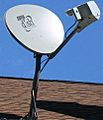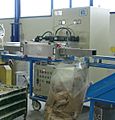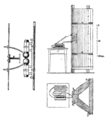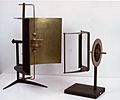Microwave facts for kids
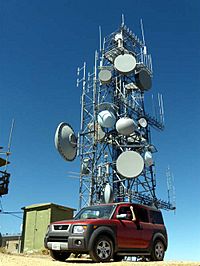
A microwave is a kind of high-frequency radio wave. It is often used to heat food in a microwave oven.
When something moves, it almost always has a wave pattern to its movement - this can be seen in water most easily, with ripples and ocean waves. A very common type of wave in the universe is electromagnetic waves. Light is an example of an electromagnetic wave, and so is a microwave. We can only see electromagnetic radiation in the visible light spectrum (which is why it's called the visible light spectrum), so microwaves are invisible.
Radio telescopes and radar mostly use microwaves.
Ovens
Microwave ovens work because microwaves make polar molecules (that is, molecules that act like tiny magnets) all face the same direction - to visualize it, imagine that the microwave oven is telling all of the molecules to face left. Then, the microwave oven reverses the waves, so that all of the molecules have to face the other direction - right, in this case.
Heat is just the movement of molecules, so when the microwave oven tells the molecules to turn left, then right, then left, over and over again, this makes them get hotter.
Water is the most common polar molecule in food, which is why dry foods don't tend to heat as well, or at all, in microwaves. Microwaves get absorbed by these polar molecules, but are ignored by non-polar molecules, and this is why microwaves can penetrate deep into certain kinds of food faster than regular heat. This is also why microwaves don't heat many plastics - those plastics that are non-polar get ignored, so the microwaves go straight through to the food.
Metals tend to spark in microwaves, rather than heating. The reason why is that metals like to give away electrons, so when the microwaves "push" at their magnet-like electrons, instead of turning, they just give the electrons away. A bunch of electrons running off on metal is called electricity, and we see it in the form of sparks.
Images for kids
-
Waveguide is used to carry microwaves. Example of waveguides and a diplexer in an air traffic control radar
-
A satellite dish on a residence, which receives satellite television over a Ku band 12–14 GHz microwave beam from a direct broadcast communications satellite in a geostationary orbit 35,700 kilometres (22,000 miles) above the Earth
-
Small microwave oven on a kitchen counter
-
1.2 GHz microwave spark transmitter (left) and coherer receiver (right) used by Guglielmo Marconi during his 1895 experiments had a range of 6.5 km (4.0 mi)
-
ku band microstrip circuit used in satellite television dish.
-
Heinrich Hertz's 450 MHz spark transmitter, 1888, consisting of 23 cm dipole and spark gap at focus of parabolic reflector
-
Jagadish Chandra Bose in 1894 was the first person to produce millimeter waves; his spark oscillator (in box, right) generated 60 GHz (5 mm) waves using 3 mm metal ball resonators.
-
Microwave spectroscopy experiment by John Ambrose Fleming in 1897 showing refraction of 1.4 GHz microwaves by paraffin prism, duplicating earlier experiments by Bose and Righi.
-
Augusto Righi's 12 GHz spark oscillator and receiver, 1895
-
Randall and Boot's prototype cavity magnetron tube at the University of Birmingham, 1940. In use the tube was installed between the poles of an electromagnet
-
British Mk. VIII, the first microwave air intercept radar, in nose of British fighter. Microwave radar, powered by the new magnetron tube, significantly shortened World War II.
See also
 In Spanish: Microondas para niños
In Spanish: Microondas para niños




